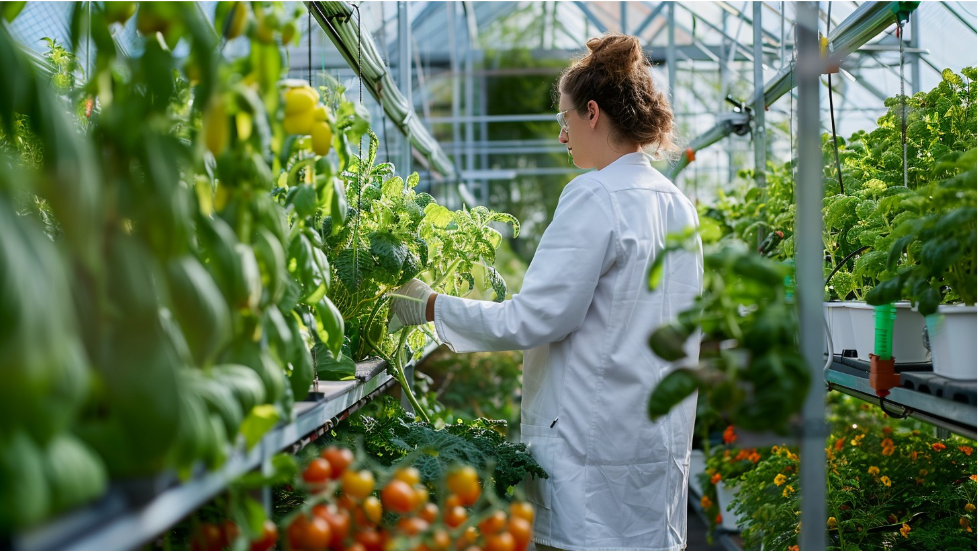Organic farming, a cornerstone of sustainable agriculture, has gained traction globally, covering 96 million hectares and engaging 4.5 million farmers across 188 countries in 2022, according to FiBL and IFOAM – Organics International. Its emphasis on natural inputs, such as manure derived from livestock, compost, and green manure, supports a circular economy, reduces waste, and produces healthier foodstuffs. However, questions about its affordability, accessibility for financially excluded demographics, and potential for yield optimization through innovations like organic vertical farming remain critical. This article expands on the principles of organic farming, delves into price comparisons with conventional methods, evaluates sustainability for marginalized communities, and explores how integrating organic practices with vertical farming could enhance yields and reduce food prices.
Recap of Organic Farming Principles
Organic farming prioritizes ecological balance, biodiversity, and the avoidance of synthetic inputs like chemical fertilizers, pesticides, and GMOs. Practices such as crop rotation, composting, and biological pest control maintain soil health and reduce environmental impact. Natural manure plays a pivotal role by recycling nutrients, enhancing soil fertility, and minimizing waste. For example, composting livestock manure and crop residues diverts an estimated 10 million tons of organic waste from landfills annually in Europe, reducing methane emissions and supporting a circular economy. Organic produce also tends to have lower pesticide residues and higher nutrient content, such as up to 55% more phenolic compounds in organic tomatoes, as shown in a 2019 Environmental Research study.
Price Comparisons: Organic vs. Conventional Farming
Production Costs
Organic farming often incurs higher production costs due to labor-intensive practices and the absence of synthetic inputs. For instance, manual weed control and organic pest management require more time and effort than chemical alternatives. A 2020 study by the USDA found that organic crop production costs in the U.S. were 10-20% higher than conventional methods, primarily due to labor and certification expenses. However, organic systems reduce reliance on costly external inputs like synthetic fertilizers, which can account for 30-40% of conventional farming costs, according to the FAO. Natural manure, sourced locally from livestock or compost, further lowers input costs over time as soil fertility improves.
Retail Prices
Organic food typically commands premium prices due to higher production costs and consumer demand for “clean” products. In 2022, global organic food sales reached $135 billion, with organic produce often priced 20-50% higher than conventional counterparts. For example, in the U.S., organic apples averaged $2.50 per pound compared to $1.50 for conventional apples in 2023, per USDA market data. In Europe, organic milk was priced at €0.60-€0.80 per liter versus €0.40-€0.50 for conventional milk. These premiums reflect certification costs, smaller-scale production, and perceived health and environmental benefits.
Long-Term Economic Benefits
Despite higher upfront costs, organic farming can be more cost-effective over time. Improved soil health reduces the need for external inputs, and organic farms are more resilient to climate variability, minimizing yield losses during droughts or extreme weather. The Rodale Institute’s 40-year Farming Systems Trial (1981-2021) showed that organic systems achieved comparable profits to conventional ones after the initial transition period (2-3 years) due to lower input costs and premium pricing. Additionally, programs like O-Farms in East Africa, which repurpose agricultural by-products (e.g., rice husks for fertilizer), create value-added products, boosting farmer incomes.
Sustainability for Financially Excluded Demographics
Financially excluded demographics—such as smallholder farmers, rural communities, and low-income consumers—face unique challenges in accessing organic farming’s benefits. However, organic practices, particularly those leveraging natural manure, offer pathways to sustainability and economic inclusion.
Benefits for Smallholder Farmers
Smallholder farmers, who manage 70% of agricultural land in developing countries, often lack access to capital for synthetic inputs. Organic farming’s reliance on locally sourced manure and compost reduces dependency on expensive fertilizers, which can cost $100-200 per hectare annually in Sub-Saharan Africa, per IFDC data. Initiatives like O-Farms in Kenya, Uganda, and Ethiopia provide training, mentorship, and seed funding to small and medium enterprises (SMEs), enabling them to adopt circular agribusiness models. For example, SMEs repurposing fruit waste into jams or livestock manure into biogas generate additional revenue streams, with some O-Farms participants reporting 20-30% income increases.
Organic certification, however, remains a barrier due to costs ($500-$2,000 per farm, depending on region) and complex requirements. To address this, group certification models, like those in India’s Participatory Guarantee Systems (PGS), reduce costs by allowing farmer collectives to share certification expenses, making organic farming more accessible.
Accessibility for Low-Income Consumers
High retail prices limit organic food access for low-income consumers. In developed countries, organic produce is often 30-50% more expensive, while in developing nations, the price gap can be even wider due to limited supply chains. Community-supported agriculture (CSA) models and urban farmers’ markets have emerged as solutions, connecting organic farmers directly with consumers to reduce costs. For instance, in India, organic farmers’ cooperatives have lowered prices by 10-15% by bypassing intermediaries. Subsidies and government programs, such as the EU’s Common Agricultural Policy, which allocated €12 billion for organic farming in 2021-2027, can further improve affordability by supporting production and distribution.
Environmental and Social Sustainability
For financially excluded communities, organic farming’s environmental benefits—such as reduced water pollution and enhanced biodiversity—translate into long-term sustainability. Conventional farming’s reliance on chemical fertilizers contributes to 50% of agricultural nitrogen pollution, per the IPCC, disproportionately affecting rural communities near water sources. Organic systems, using natural manure, reduce nitrogen runoff by 30-40%, protecting water quality for marginalized groups. Additionally, organic farms’ higher biodiversity (30-50% more species, per a 2015 Journal of Applied Ecology study) supports pollinators, crucial for smallholder crop yields.
Organic Vertical Farming: A Game-Changer for Yields and Prices
Vertical farming, which involves growing crops in stacked layers under controlled environments, offers a promising avenue to address organic farming’s yield and cost challenges. When combined with organic practices, it can significantly increase productivity, reduce land use, and lower food prices, particularly for urban and financially excluded populations.
Principles of Organic Vertical Farming
Organic vertical farming integrates organic principles—such as natural manure-based fertilizers and biological pest control—into high-tech systems. Instead of synthetic hydroponic nutrients, vertical farms can use compost teas or liquid manure derived from anaerobic digestion. LED lighting, precise irrigation, and climate control optimize growth while maintaining organic standards. For example, companies like AeroFarms have experimented with organic-compliant nutrient solutions, achieving yields up to 390 times higher per square meter than traditional field farming.
Yield Advantages
Organic field farming typically yields 10-20% less than conventional methods due to the absence of synthetic inputs. Vertical farming overcomes this by maximizing space and resource efficiency. A 2023 study in Urban Agriculture & Regional Food Systems found that vertical farms can produce 10-20 tons of leafy greens per hectare annually, compared to 1-2 tons for organic field farming. By integrating organic practices, such as manure-based nutrients, these systems maintain environmental benefits while boosting output. For instance, organic vertical farms in Singapore have achieved 95% water savings and zero pesticide use, aligning with circular economy principles.
Price Reduction Potential
Higher yields and reduced land requirements can lower organic food prices. Vertical farms’ proximity to urban centers cuts transportation costs, which account for 10-15% of conventional produce prices. By scaling production, organic vertical farming could reduce the price gap between organic and conventional foods. For example, a 2022 pilot project in Dubai using organic vertical farming lowered organic lettuce prices by 20% compared to imported organic produce. For financially excluded urban consumers, this could make organic food more accessible, especially in food deserts.
Sustainability and Circular Economy
Organic vertical farming enhances the circular economy by recycling organic waste into nutrients. Urban food waste, which constitutes 30-40% of municipal waste in cities, can be composted or digested to produce fertilizer for vertical farms. This reduces landfill waste and methane emissions while providing a sustainable nutrient source. Additionally, vertical farms use 70-95% less water than field farming, addressing water scarcity issues critical for marginalized communities in arid regions.
Challenges
Organic vertical farming faces hurdles, including high initial costs (e.g., $1-2 million for a small-scale facility) and energy demands for lighting and climate control. Maintaining organic certification in controlled environments is also complex, as standards for hydroponic or aquaponic systems vary by region. However, renewable energy integration and technological advancements are reducing costs, with some vertical farms reporting 30% energy savings through AI-optimized systems.
Comparative Analysis: Organic Field vs. Organic Vertical vs. Conventional Farming
| Aspect | Organic Field Farming | Organic Vertical Farming | Conventional Farming |
|---|---|---|---|
| Production Costs | 10-20% higher than conventional; reliant on labor and manure | High initial investment but lower long-term input costs | Lower labor costs but high input costs (fertilizers, pesticides) |
| Retail Prices | 20-50% higher than conventional | Potential to reduce prices by 10-20% with scale | Lowest prices but chemical residues |
| Yields | 10-20% lower than conventional | 10-20x higher per square meter than field farming | Highest in optimal conditions |
| Sustainability | High; reduces waste, enhances biodiversity | High; water-efficient, urban waste recycling | Low; pollution, soil degradation |
| Accessibility | Limited for low-income groups; certification barriers | Urban-focused, can lower prices for marginalized communities | Widely accessible but environmental costs |
| Circular Economy | Strong; manure and waste recycling | Strong; urban waste integration | Weak; reliance on finite inputs |
Conclusion
Organic farming, with its reliance on natural manure, fosters a circular economy, reduces waste, and produces healthier foodstuffs, but its higher costs and lower yields pose challenges for financially excluded demographics. In 2022, its global reach of 96 million hectares underscored its potential, yet retail prices remain 20-50% higher than conventional products. For smallholder farmers, organic practices lower input costs and increase resilience, while programs like O-Farms enhance economic inclusion through circular agribusiness. However, affordability for low-income consumers requires innovative solutions like subsidies and direct market models.
Organic vertical farming offers a transformative solution, combining organic principles with high-yield, space-efficient systems. By achieving yields up to 390 times higher per square meter and reducing water and transport costs, it could make organic food more affordable, particularly in urban areas. While challenges like high setup costs persist, integrating organic vertical farming with circular waste management aligns with sustainability goals and benefits financially excluded communities. Together, these approaches position organic farming as a cornerstone of a resilient, equitable, and sustainable global food system.



